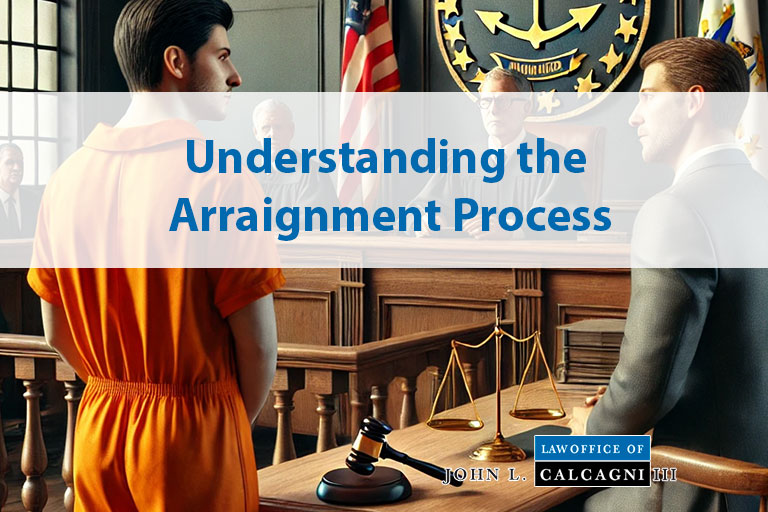Understanding the Arraignment Process

This article is designed to promote a basic understanding of the arraignment process in the American Criminal Justice System. While the details of the arraignment process may vary by individual jurisdiction, the overall process is uniform throughout state and federal courts.
Contents
Definition and Purpose of Arraignment
The arraignment is a defendant’s first court appearance in a pending criminal case. At the arraignment, four basic things occur:
- The defendant is given notice of the pending charges.
- The defendant is called upon to answer or enter a plea to the newly filed charges.
- The defendant is advised of his right to and asked to make a choice regarding his or her legal representation.
- The judge addresses the issue of bail.
Each of these four components is described further below.
The Arraignment Process
Notice of Pending Charges
The prosecution, also referred to as the State, the Government, the Commonwealth, or the People, is responsible for filing criminal charges against the defendant in a criminal case. Criminal charges are reduced to writing in a charging document that is filed with the court and becomes part of the public court record. Charging documents come in various forms such as criminal complaints, criminal information documents, or indictments.
The charging document, regardless of type, typically lists out each criminal charge and describes in summary the date, place, and manner by which the defendant is accused of violating the law. At the arraignment, the presiding judge will orally inform the defendant of the criminal charges, or accusations set forth in the charging document, and cause the defendant and/or his attorney to be provided with a written copy of the charges.
Enter a Plea to the Charges
After the defendant is formally advised of the pending charges, he or she is called upon to answer the charges by entering a plea. In the vast majority of jurisdictions, acceptable pleas in a criminal case include not guilty, guilty, and nolo contendere or no contest.
Since the arraignment occurs in the beginning of a criminal case and typically before the defendant has received any discovery or evidence in support of the charges, most defendants enter not guilty pleas. Depending on the jurisdiction, the not guilty plea entered at arraignment may be spoken before the court by the defendant or the attorney for the defendant on the client’s behalf.
Election of Counsel
At arraignment, the court is tasked with ensuring that the defendant has legal representation. Though defendants in the criminal justice system are entitled to represent themselves, this is highly frowned upon and discouraged. Self-represented defendants are given no leeway and are expected to conduct themselves as trained and experienced lawyers, demonstrating knowledge of and complying with all procedural and substantive legal requirements.
Many defendants appear for arraignments with attorneys. Those who appear unrepresented will be asked if they intend to hire private counsel or if they wish to be considered for the appointment of public counsel. Those seeking the appointment of public counsel must demonstrate a financial need or inability to pay for a private attorney before being assigned a public defender or other appointed attorney.
Bail
The final step in the arraignment process is for the judge to address the issue of bail. Bail refers to what the court should do with a defendant between the time of arraignment, when the criminal case begins, until some undetermined time in the future when the case ends, whether by trial, guilty plea, or dismissal. The law of bail is concerned with two main things: is the defendant a flight risk and does releasing the defendant pose a danger to the community.
On one end of the bail spectrum, bail may be as simple as releasing a defendant on his or her promise to return to court when directed. This is known as personal recognizance. Further along the spectrum, bail may require the defendant to post a sum of money with the Court, to be held during the pending of the case and returned at the end of the case, so long as the defendant makes all required court appearances.
If a defendant fails to appear as directed, the money may be forfeited. Bail may also include conditions such as complying with no contact or no trespass orders, abstaining from drug and/or alcohol use, attending substance abuse treatment or mental health counseling, and abiding by curfews and travel restrictions. Some defendants who are released on bail may also be subject to electronic monitoring and home detention.
On the far opposite end of the bail spectrum, a defendant who poses a significant flight risk or danger to the community may be denied bail and ordered into pretrial detention during the pendency of his case.
Importance of the Arraignment Process
The arraignment process is a fundamental step in any criminal case. In addition to the four things referenced above, the occurrence of the arraignment triggers the clock on a defendant’s right to a speedy trial. It also triggers the government’s obligations to provide the defense with discovery, which consists of the evidence and information in the government’s possession, custody, or control that support the pending criminal charges. If you are charged with a crime and have any questions about the arraignment process, call Criminal Defense Lawyer, John L. Calcagni III, today for a free consultation at (401) 351-5100.
